
Saturday | July 27, 2019
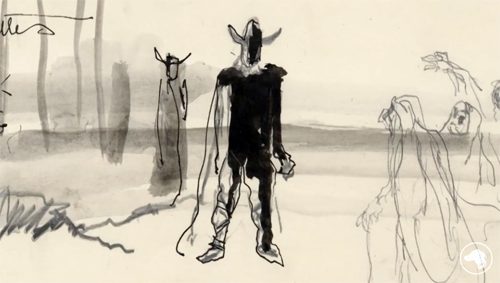
Kristin here:
David and I started this blog way back in 2006 largely as a way to offer teachers who use Film Art: An Introduction supplementary material that might tie in with the book. It immediately became something more informal, as we wrote about topics that interested us and events in our lives, like campus visits by filmmakers and festivals we attended. Few of the entries cite Film Art, but most of them are relevant.
Every year shortly before the autumn semester begins, we offer this list of suggestions of posts that might be useful in classes, either as assignments or recommendations. Readers who aren’t teaching or being taught might find the following round-up a handy way of catching up with entries they might have missed. After all, we have posted well over 900 entries, and despite our excellent search engine and many categories of tags, a little guidance through this flood of texts and images might be useful.
This list starts after last August’s post. For past lists, see 2007, 2008, 2009, 2010, 2011, 2012, 2013, 2014, 2015, 2016, 2017 and 2018.
Last year for the first time I included recommendations for potentially useful videos in our series “Observations on Film Art” (a sort of extension of this blog) on the FilmStruck streaming service. Every month Jeff Smith (also our collaborator on Film Art), David, and I had contributed a visual essay that applied concepts from Film Art: An Introduction to a film (or films) streaming on FilmStruck, which began in November of 2016 and ended in November of 2018.
Fortunately in April, 2019, that platform was replaced by The Criterion Channel, which had been a major attraction as part of FilmStruck. The essays that we had contributed to FilmStruck have all been reposted on the new service, and we have continued to contribute monthly essays. As of now there are 29 essays online. See last year’s “Is there a blog in this class? 2018” for the earlier videos. (For information on the changeover of services, see here.)
Chapter 1 Film as Art: Creativity, Technology, and Business
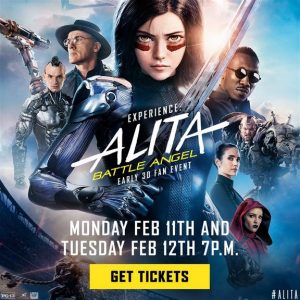
I’ve written an occasional series on the progress of 3D in modern cinema. In an entry concentrating on exhibition rather than the technology or the movies, I talk about the decline in the number of 3D screenings as they lose popularity: “3D in 2019: RealDivided?”
In Chapter 1 we briefly deal with the concept of the author or auteur of a film. David provides an example of how one characterizes an auteur’s work in “Terence Davies: sunset songs.” Is Michael Curtiz as clearly an auteur as Orson Welles is? This entry considers some evidence.
No year on the blog is complete, it seems, without something on Hitchcock. This time David considered Notorious, preparing the way for a video essay for the Criterion release of this masterpiece.
At greater length, our updated e-book on Christopher Nolan is a study of him as an auteur with a “formal project.” David discusses the changes in “Christopher Nolan: Back into the Labyrinth.” A later entry considers (unconvincing) critical attacks on Nolan’s work.
Chapter 3 Narrative Form
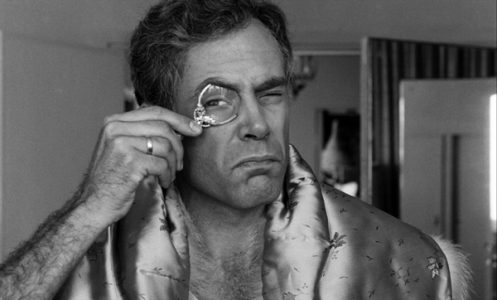
In The Criterion Channel video essay, #25, “Lydia and the power of flashbacks,” David discusses the somewhat experimental ways in which flashbacks are used in Julien Duvivier’s 1941 romance. He extends his analysis in “Lovelorn LYDIA: A new installment on The Criterion Channel.”
I analyze one aspect of narrative form in The Favourite: “Balancing three protagonists in THE FAVOURITE.”
Narrative options both old (the 1940s) and new (Happy Death Day 2U) are considered in an entry on how incidents can be repeated and varied, within a film and from film to film.
This chapter of Film Art discusses narration in terms of depth, how much of characters’ knowledge and thoughts are revealed to us. In “Observations on Film Art” #26 on The Criterion Channel, Jeff examines technique that allow us access to the protagonist’s mind in “Memories of Underdevelopment.” He expands on that analysis in “Politics and Subjectivity: MEMORIES OF UNDERDEVELOPMENT on The Criterion Channel.”
Can the tools of narrative analysis shed light on The Narrative of contemporary US politics? David tries in the entry “Reliable narrators? Telling tales on Trump.”
Chapter 4 The Shot: Mise-en-scene
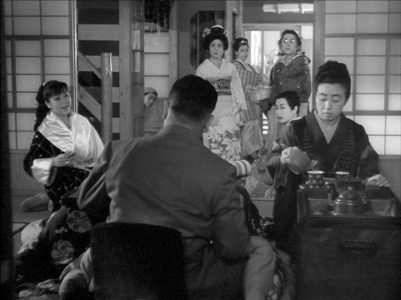
#27 in our “Observations on Film Art” on The Criterion Channel, David examines the intricate mise-en-scene of Kenji Mizoguchi: “Games of Vision in STREET OF SHAME.” He elaborates on the blog with “How to hypnotize the viewer: Mizoguchi’s STREET OF SHAME on The Criterion Channel.”
David analyzes the staging of a scene in Augusto Genina’s Il Maschera e il Voto (The Mask and the Face, 1919) in “Sometimes an actor’s back …” Those of you teaching Film History: An Introduction might find this entry useful in relation to the discussion of tableau staging in Chapter 2.
Chapter 5 The Shot: Cinemagraphy
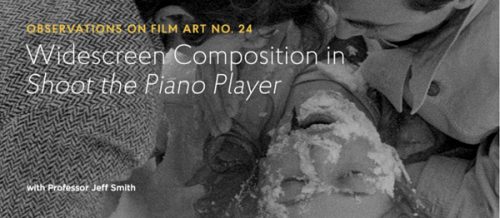
In The Criterion Channel’s #24 in the “Observations on Film Art” series, Jeff Smith analyzes “Widescreen Composition in Shoot the Piano Player.” He offers additional commentary on the subject in a blog entry, “On The Criterion Channel: Jeff Smith on SHOOT THE PIANO PLAYER.”
Chapter 6 The Relationship of Shot to Shot: Editing
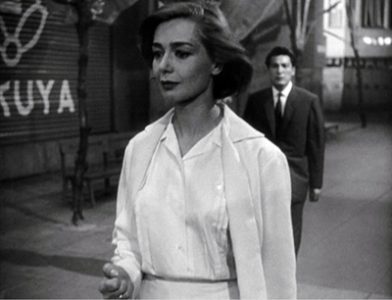
In The Criterion Channel’s #23 video, “Mutations of Memory–Editing in Hiroshima Mon Amour,” David discusses the film’s complex, innovative use of editing to create flashbacks. He expands on that analysis in the blog entry, “On The Criterion Channel: Five reasons why HIROSHIMA MON AMOUR still matters.”
Dissolves provide a way to join shot to shot. They’re usually used sparingly and in conventional ways (flashbacks, ellipses). In “Observations on Film Art” #22 on The Criterion Channel, “Dissolves in The Long Days Closes,” I discuss how dissolves become a prominent formal device in Terence Davies’ film.
Chapter 7 Sound in the Cinema
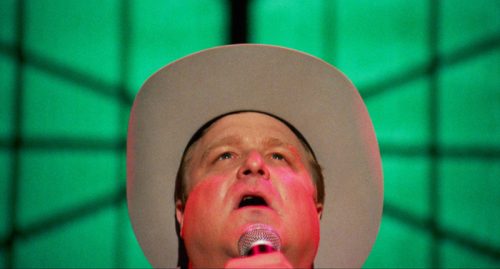
Guest blogger Jeff Smith analyzes the music in True Stories: “From transistors to transmedia: Talking Heads tell TRUE STORIES.”
Jeff takes an informative look at the five songs from 2018 films nominated for Oscars in “Oscar’s siren song: The return: a guest post by Jeff Smith.”
Chapter 8 Summary: Style and Film Form
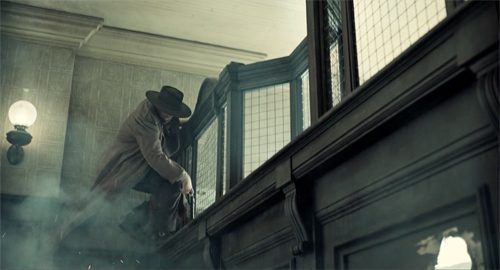
David analyzes cutting and framing in one scene in the Coen Brothers’ The Ballad of Buster Scruggs in “The spectacle of skill: BUSTER SCRUGGS as master-class.”
The great critic André Bazin decisively shaped our sense of how to understand film form and style. David explores some of his ideas in “André Bazin, man of the cinema” and an essay, “Lessons with Bazin.”
Chapter 9 Film Genres
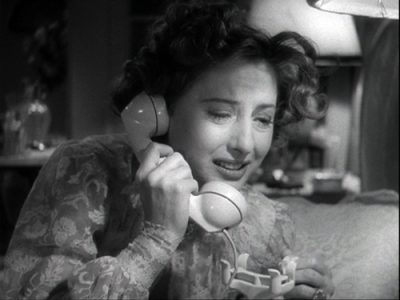
David on film noir: “REINVENTING HOLLYWOOD in paperback: much ado about noir things.”
Chapter 10 Documentary, Experimental, and Animated Films
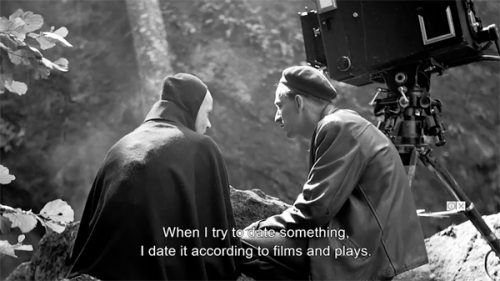
Reporting from the Vancouver festival, David discusses two documentaries that might be useful to show if you program films by either of these directors for your class: The Eyes of Orson Welles and Bergman: A Year in the Life. See his “Vancouver 2018: Two takes on two directors.”
David on three documentaries shown at our hometown film festival this year, in “Wisconsin Film Festival: Not docudramas but docus as dramas.”
Chapter 11 Film Criticism: Sample Analyses
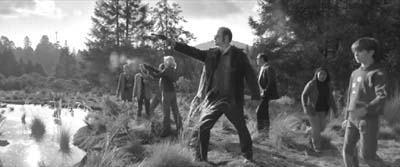
We were lucky enough to return to the Venice International Film Festival last year, again offering analyses of some of the films we saw. These are much shorter than the ones in Chapter 11, but they show how even a brief report (of the type students might be assigned to write) can go beyond description and quick evaluation.
The first entry deals with the world premiere of Damien Chazelle’s First Man and is based on a single viewing. The second discussed Alfonso Cuarón’s Roma and Mike Leigh’s Peterloo.The third offered David’s thoughts on the posthumous release version of Orson Welles’s The Other Side of the Wind. In a fourth, I dealt with five films from the Middle East, including Amos Gitai’s A Tramway in Jerusalem. David considers variants of wrong-doing in films from around the world, including Zhang Yimou’s Shadow and Erroll Morris’ American Dharma. Sixth and last was my longer analysis of László Nemes’s brilliant but challenging second feature, Sunset. We plan to carry on this tradition of comments on new films when we attend the Venice International Film Festival next month.
Our annual visit to the Vancouver International Film Festival yielded more brief analyses of new films. In “Vancouver 2018: Landscapes, real and imagined,” David looks at some recent Asian films, including Kore-edge Hirozaku’s Shoplifters. In “Vancouver 2018: A panorama of the rest of the world,” I comment on three films by important international directors: Nuri Bilge Ceylon’s Turkish The Wild Pear Tree, Benedikt Erlingsson’s Icelandic Woman at War, and Pavel Pavlikowski’s Polish Cold War.
I followed up with more international films in “Vancouver 2018: Panorama of the rest of the world, the sequel“: Matteo Garrone’s Italian Dogman, Nina Paley’s American Sedar-Masochism, Wolfgang Fischer’s Austrian Styx, and Christian Petzold’s German Transit. David wrote about crime films (and a TV show) in “Vancouver 2018: Crime waves.” These notably included Lee Chang-dong’s Burning. Our wrap-up, “Vancouver 2018: A few final films,” again had an international flavor, commenting on Jafar Panahi’s Iranian 3 Faces (his defiant fourth feature since the government banned him from filmmaking for twenty years), Nadine Labaki’s Lebanese Capernaum, and Ciro Guerra and Cristina Gallego’s Colombian Birds of Passage.
Looking back on these two festivals makes it clear that 2018 was an extraordinary year for the cinema!
David analyzes True Stories on the occasion of its release on Blu-ray: “Pockets of Utopia: TRUE STORIES.”
Chapter 12 Historical Changes in Film Art: Conventions and Choices, Tradition and Trends
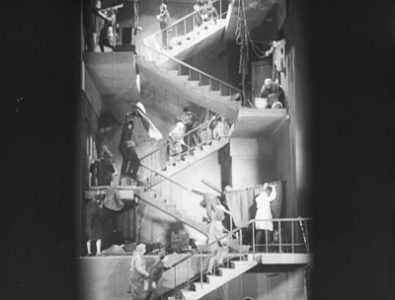
Teaching film history? My annual choice of the ten best films from 90 years ago offers some familiar and not-so-familiar titles: “The ten best films of … 1928.” I also consider two releases of major German silent films.
Many of our entries from Il Cinema Ritrovato in Bologna consider older films, especially those from 1919 in “German and Scandinavian classics.” I discuss some major African films in “Who put the pan in Pan-African cinema?”
I discussed a Blu-ray release of two rare films by Mary Pickford in “Pickford times two.”
A more recent trend in film history, that of the improvised independent American film, is considered in our review of J. J. Murphy’s book Rewriting Indie Cinema.
Finally, for Film Art: An Introduction users, an account of how Jeff Smith, David, and I revised our textbook for its twelfth edition.
After forty years, we’re still grateful to teachers and students who have found Film Art: An Introduction useful in their study of cinema.
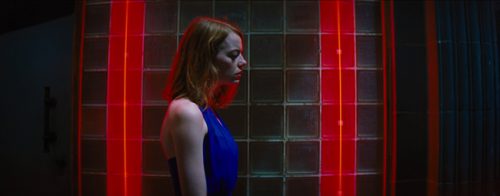
Posted in FILM ART (the book), Film comments, Film history, Narrative strategies, Poetics of cinema, Silent film |  open printable version
| Comments Off on Is there a blog in this class? 2019 open printable version
| Comments Off on Is there a blog in this class? 2019
Thursday | July 18, 2019
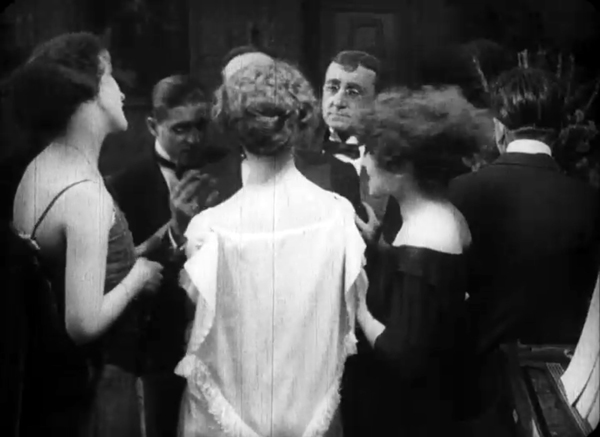
Il Maschera e il Volto (1919).
…can crisply punctuate a scene.
DB here:
One of the 1919 films on display at Cinema Ritrovato this year was Augusto Genina’s Il Maschera e il Volto (The Mask and the Face, 1919). It’s drawn from a popular play that satirized the erotic stratagems of the elite. The movie begins by introducing a gaggle of couples at a Lake Como house party, so I expected that it would create interlocking intrigues in the manner of silent-era Lubitsch films like The Marriage Circle (1924). Not so: the plot concentrates on one romantic triangle. The version we have, at 1799 meters, might be a little shorter than the original (said to be around 1900 meters), but it seems likely that the plot we have dominated the initial release too.
Savina is betraying her husband Paolo with the family lawyer Luciano. During the house party Paolo declares that a cuckolded husband has every right to murder the unfaithful wife. When he learns of Savina’s affair (but not Luciano’s complicity), he orders her to leave the household immediately. Paolo declares that she will become dead to him and their friends.
Paolo tells Luciano that he killed Savina. We get a lying flashback (yep, already and again) that shows him strangling her and dumping her body in the lake. Savina overhears his false confession. When she hears Luciano asserts that she got what she deserved, she realizes he’s worthless. Disillusioned about both of the men in her life, she follows Paolo’s order and leaves their estate.
Of course a woman’s corpse, face mutilated, is soon found in the lake. Now Paolo must stand trial for Savina’s murder, and Luciano must defend him.
Not the funniest comedy I ever saw, but it has a grim charm. One particular scene made me happy.
Piano ensemble
Readers of this blog know that I like to study staging in 1910s films, and Genina provided nifty examples in the 2017 Ritrovato season. Like the Lupu Pick film I reviewed at this year’s jamboree, Il Maschera lies stylistically midway between pure tableau cinema and editing-driven construction. Interior scenes are often broken up by many cuts, but they’re typically axial, straight-in and straight-back, without reverse angles. (The exception is the trial scene. As in many 1910s films, it creates a more immersive space through “all-over” cutting.) In most scenes, the shots enlarge actors to follow their responses, but we don’t get setups that penetrate the space, putting us inside the flow of action.
Still, axial cuts, as Eisenstein and Kurosawa and John McTiernan knew, have a peculiar power. They can be abrupt and punchy, or more subtle in readjusting the framings. The latter option is on display in the film’s first big scene, when all the guests gather in the salon around the piano.
The scene runs about two and half minutes and consists of twelve shots and six dialogue titles. What’s worth noticing is the slight variations in setups, coordinated with what Charles Barr has felicitously called “gradation of emphasis.” Often the changing setups are masked by an inserted dialogue title, so there are no bumps in continuity.
The orienting view is a bustling shot that piles up faces and shoulders along the horizontal axis.
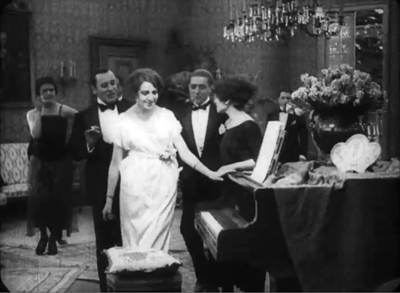 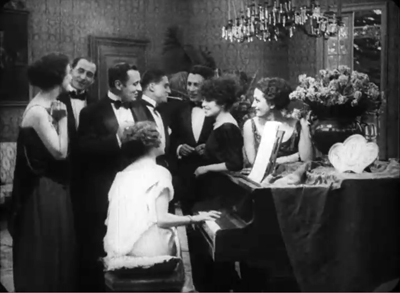
In an axial cut-in, the guests debate the righteousness of Othello’s murder of Desdemona. A further cut-in shows Luciano and Savina on the far right sharing glances. (The curly-haired woman will prove an innocent witness.) It’s a Hitchcockian situation, but without the POV singles.
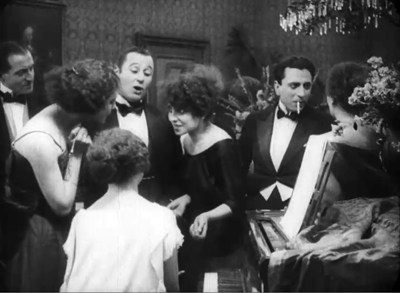 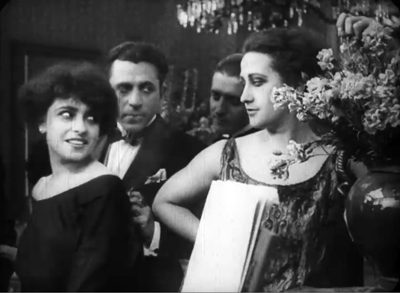
Soon an older husband rises from his chair in the rear (another cut-in, “through” the group) and comes forward to join them. He draws alongside the husband to calm him down.
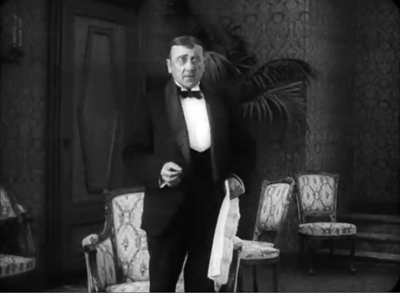 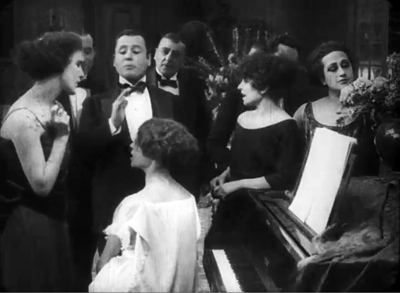 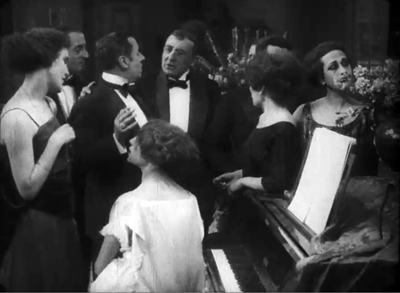
I’ve talked about crowded tableaus like this before. The Americans I survey were somewhat bolder than Genina in jamming the heads even closer together, creating partial faces that float out of the background. Genina has, however, other goals in view.
The woman in white
During the cut-ins, Genina takes the opportunity to rearrange the actors around the piano and re-scale his shots. There are five distinct variants of the piano grouping; even setups that might seem the same aren’t quite. There are two setups of the adulterous couple. All these are calibrated to suit the action presented.
For instance, when Paolo launches his rant about unfaithful women, the framing is tighter to favor him, and the foreground woman in white is primed for her big moment.
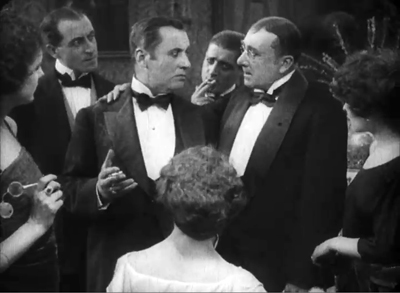
Similarly, the second cut to the adulterous couple is framed somewhat differently from the earlier one (on left), with Luciano pushing aside the cute curlyhead. He and Savina are listening more intently to Paolo’s denunciation of faithless wives.
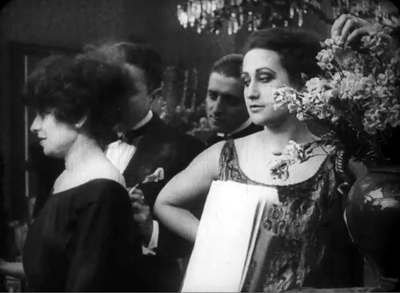 
So what seem to be fairly straightforward repetitions of setups are in fact minutely adjusted to favor certain actions. This strategy allows Genina to return to the whole ensemble.
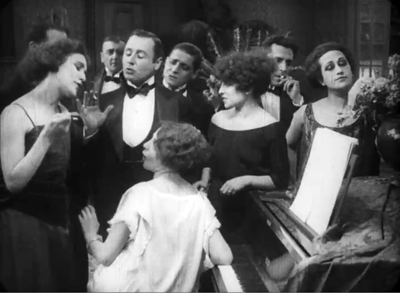
In a closer view, the woman in white suggests that they stop arguing about infidelity and go in to play cards. She rises, blotting out Paolo in mid-rant.
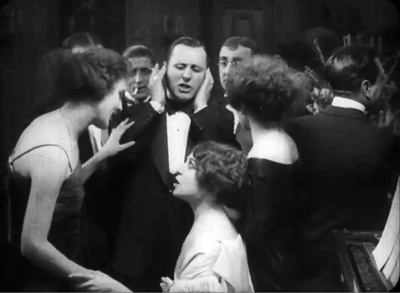 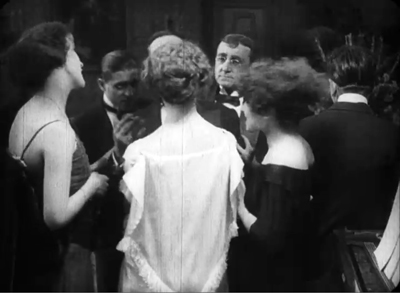
The effect would be less pointed if she were in black like the other women.
Everyone but the older husband turns away, and people retire to the next room in the distance. They drain the space like water emptying out of a tub. That leaves what filmmakers today would call the scene’s button: the old man noticing that Luciano and Savina don’t join the group. Throughout the scene they’ve been literally marginalized on the far right.
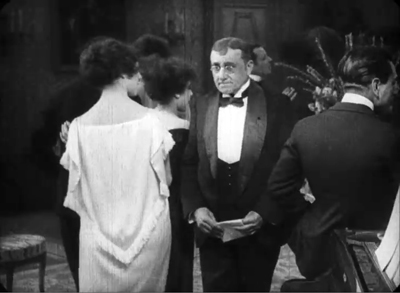 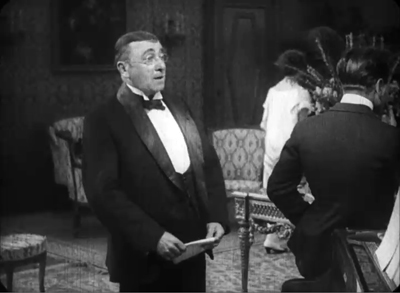
It’s through this older man we just barely see the couple leave. He seems to understand the game they’re playing. and now he watches them disappear, perhaps to a private rendezvous.
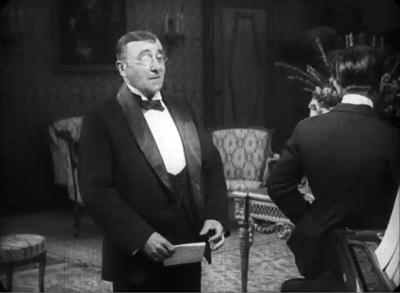 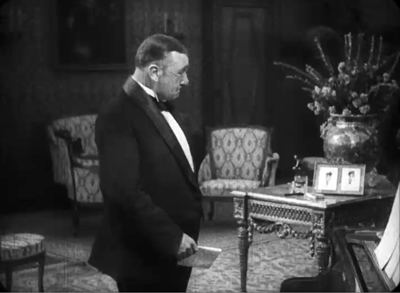
The scene ends with another turning from the camera, another actor’s back letting us know the action is done.
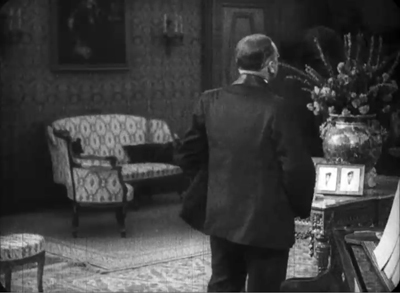
Very often, turning from the camera signals the end of scenes, and of films.
It would have been fairly easy for any director to simply let the actors clustered around Paolo drag him off to play cards. But by having the woman in the foreground pop up, cut off our view of Paolo, and trigger a general exit Genina makes the action taper off briskly. Staging in the silent cinema is full of such little felicities, and it’s one job of criticism to appreciate them. It’s especially important since such techniques seem no longer part of filmmakers’ skill sets.
Then again, some Maschera images just whack you in the eye. Who doesn’t sense passion, elaborately caged, in the image below?
Thanks as usual to the Cinema Ritrovato Directors: Cecilia Cenciarelli, Gian Luca Farinelli, Ehsan Khoshbakht, Mariann Lewinsky, and their colleagues. We particularly owe Mariann for her curating of the Hundred Years Ago series every year. Special thanks as well to Guy Borlée, the Festival Coordinator.
Information about La maschera e il volto can be found in Vittorio Martinelli’s Il Cinema Muto Italiano: I film del dopogerra/1919 (Rome: Bianco et nero, 1960), 170-172.
Other Sometimes... entries consider a single axial cut, a shot in depth, a jump cut, a reframing, and a production still.
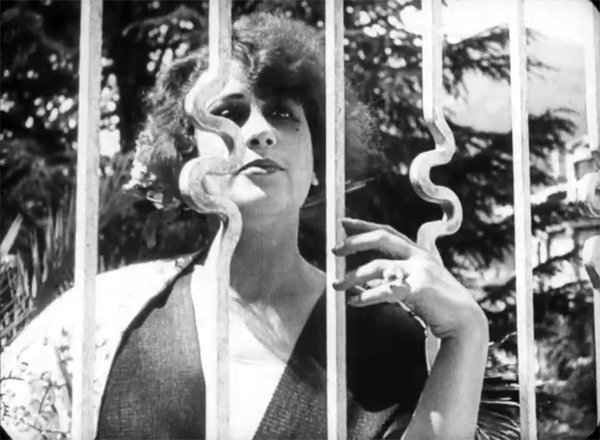
Il Maschera e il Volto (1919).
Posted in 1910s cinema, National cinemas: Italy, Silent film, Sometimes . . ., Tableau staging |  open printable version
| Comments Off on Sometimes an actor’s back… open printable version
| Comments Off on Sometimes an actor’s back…
Friday | July 12, 2019
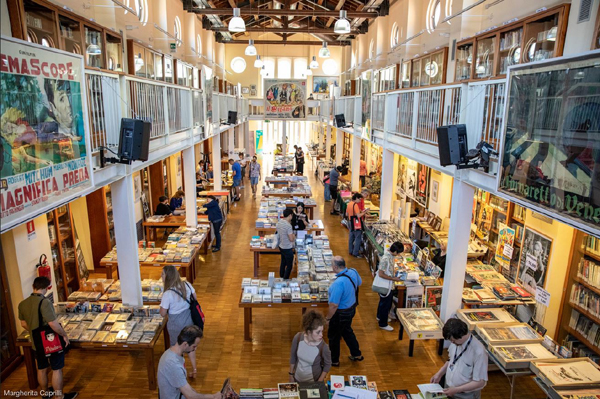
Il Cinema Ritrovato Book Fair (photograph Margherita Caprilli).
Kristin here:
I mentioned in my entry on the African thread at this year’s Il Cinema Ritrovato that I filled in blank spaces in my program with a miscellany of intriguing films. Here are some of those films I saw, and others that David saw.
O Pão (1959)
Manoel de Oliveira’s first film, the gorgeous black-and-white documentary short, Douro, Faina Fluvial, was released in 1931. His last, Um Século de Energia, another documentary short, came out in 2015, the year of his death aged 106 (as did Visita ou Memórias e Confissões, a deliberately posthumous legacy film shot in 1982). That’s an 84-year career. I doubt any other filmmaker can claim as much.
Initially that career proceeded in fits and starts. He made more documentary shorts in the 1930s and then a black-and-white feature, Aniki-Boko (1942), during the war under an authoritarian regime. After the war he could not find funding and decided to study color filmmaking in Germany. During the 1950s he applied his resulting expertise to two documentaries: O Pintor e a Cidad (“The Painter and the City,” 1956) and O Pão (Bread). A beautiful print of the latter was shown in this year’s Ritrovati e Restaurati thread. It was to be his last film before he turned to feature filmmaking, though he never entirely gave up documentaries, particularly near the end of his life.
This hour-long film slowly follows the entire progress of bread, from wheat-fields to milling to baking to consumption. The images, whether in field or factory, are lovely, showing that Oliveira had indeed learned a great deal about color.
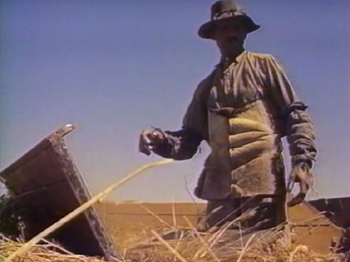 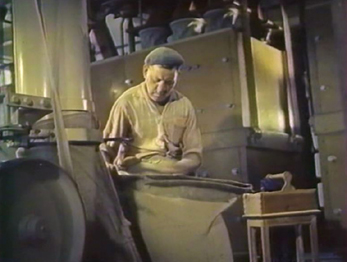 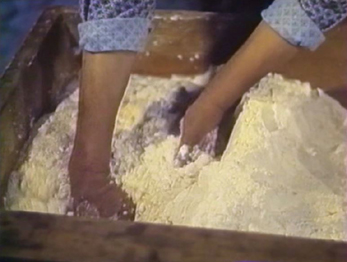
There is no voice-over narration, even during a lengthy scene in a large mill where technicians perform mysterious tests on samples of flour. The slow progression creates a soothing, almost mesmeric tone. Only toward the end does some social criticism emerge. A hungry urchin stealthily retrieves a roll dropped by a shopper, only to have it snatched away by a little street thug. Clearly bread, despite the lyricism of its production, is not for everyone.
Ghazieh-e Shekl-e Avval, Ghazieh-e Shekl-e Duvvum (1979)
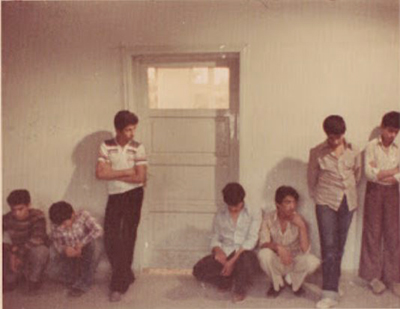
Another must-see was Abbas Kiarostami’s early film, First Case, Second Case, also presented in the rediscovered-and-restored thread. Like Oliveira, Kiarostami began in documentary work. This remarkable film was started before the 1979 Iranian Revolution and finished after it–and then banned.
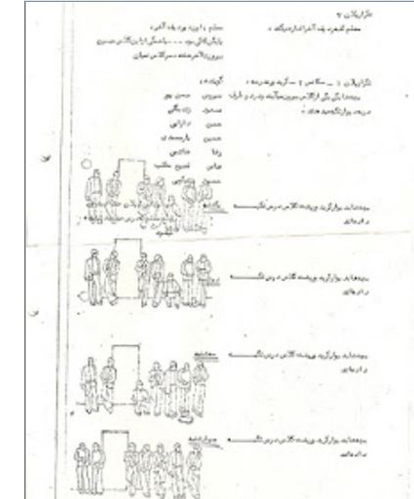
The film’s beginning rather resembles other Kiarostami openings, with a simple scene in a classroom. A teacher drawing the anatomy of an ear on a blackboard is interrupted by a knocking noise caused by one of his students. No one confesses or reveals who caused the noise, and the teacher suspends seven of the boys, who spend the next days in the hall outside the classroom.
This scene is revealed to be a 16mm film being shown to a succession of teachers, government officials, religious leaders, and the fathers of some of the boys. In the latter cases, some variant of the framing above is shown, with an arrow pointing to the son of the father being interviewed. Unseen, Kiarostami asks them the same question: did the boys do right in refusing to reveal who disrupted the class? Some of these interviewees became key figure in the Islamic Revolution. (Jason Sanders’ program notes for a screening of the film provide some information about this historical context.)
This “documentary” has of course been carefully staged. A page from Kiarostami’s script reveals how he designed the passing days of the boys’ suspension, with different ones standing or sitting each time. The illustration is from Ritrovato programmer Ehsan Khoshbakht’s blog entry on the film, where he credits First Case, Second Case with introducing the interview technique into the director’s work.
This first case shows the boys maintaining their refusal to identify the culprit. In a new scene, the second case, an alternative outcome shows one of the boys naming the guilty classmate to his teacher. Again, Kiarostami interviews many of the same people as to whether they believe the boy’s decision can be morally justified.
If not as charming as some of Kiarostami’s later work, First Case, Second Case contains a familiar combination of complexity and simplicity, as well as a fascination with people telling their own versions of events.
The film has been picked up by Janus in the USA, which should mean that it becomes available from Criterion on Blu-ray and/or its streaming service, The Criterion Channel.
Twelve O’Clock High (1949)
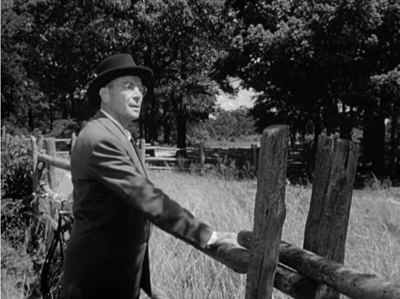
In recent years, Il Cinema Ritrovato has featured the films of a major Hollywood director as one of its main threads. This year it was Henry King. I managed to miss nearly all of his films. In part I feared that, since the auteur du jour is always one of the the more popular items in the program, the screenings would be crowded. Word of mouth suggested that they were.
Still, I had an afternoon free, and I wanted to guarantee myself a good seat for Varda par Agnès, showing later in the day. I went to an earlier screening in the same theater, and I was glad I did. Twelve O’Clock High is an impressive and entertaining film, if not an outright masterpiece.
Fitting into David’s set of innovations typical of the 1940s, the action is enclosed by a framing situation. A man we eventually discover was an American officer posted in England during World War II bicycles out into the countryside and visits the derelict remains of the military airport where he served. (Above, played by Dean Jagger in a role that won him a best-supporting-actor Oscar).
For a long time the story concentrates on General Frank Savage (Gregory Peck), who takes over command of an underperforming bomber unit in the same air station we saw at the beginning. He proves an absolute stickler for discipline, initially alienating the pilots he commands. Eventually he wins their respect, of course, and he learns to unbend a bit.
Eventually a series of air battles occur, with some very impressive and genuine combat footage, including aerial views of bombs exploding on their German targets. The film was presented in a nearly pristine 35mm print, which certainly contributed to my pleasure at having ended up at that screening somewhat by chance.
Faubourg Montmartre (1931)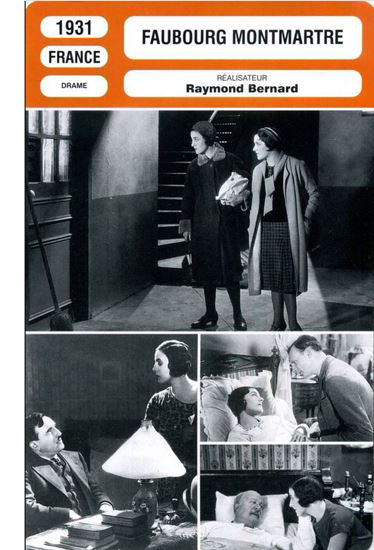
I definitely planned from the start to see this film. I very much admire director Raymond Bernard’s 1932 World War I drama Wooden Crosses, his next feature after Faubourg Montmartre. Indeed, I had done a video on it for The Criterion Channel (“Observations on Film Art” #16 “The Darkness of War in Wooden Crosses“)
While a slighter film than Wooden Crosses, Faubourg Montmartre is quite stylish and technically impressive, considering that it was Bernard’s first sound film. In it he abandons his concentration during the silent era on historical epics (his best-known being The Miracle of the Wolves, from 1924).
Here he tackles a melodrama in a contemporary setting, centering around Ginette, a somewhat naive young working-class woman, played by popular star Gaby Morlay. She and her older sister Céline live and work in the titular district of Paris, the disreputable area of cheap entertainment and brothels. Céline works as a prostitute but tries to protect Ginette from such a life. Becoming more dependent on drugs, however, she nearly dupes Ginette into following her into prostitution.
Despite its grim setting, the film has many light moments, mostly provided by the amiable Morlay. It also contains some impressive musical numbers, one a variety number by Florelle and a café song about prostitution by Odette Barencey.
The film was yet another in the festival’s Ritrovati and Restaurati thread.
Georges Franju
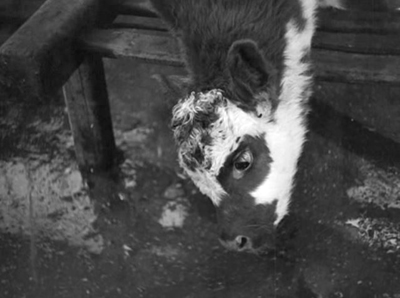
There was an unaccustomed focus on documentaries this year, which presumably was the occasion for devoting a small thread to Franju. Of the thirteen shorts which he made or at least is tentatively credited with (most of them commissioned documentaries), eleven were shown. Judex, his fiction feature paying homage to the serial of the same name by Louis Feuillade, was also on the program.
I tried to see all the Franju shorts, since only Le Sang des bêtes (above) and Hôtel des Invalides are well-known in the US. The prints shown ranged widely in quality, some being in 35mm and some 16mm. En passant par la Lorraine was almost unwatchable, though most of the rest were in varying degrees acceptable.
The most interesting revelations were perhaps Mon chien (1955), a melancholy narrative based on the common habit of people abandoning their pets in the countryside. The amazingly callous parents of the little heroine dump her beloved German shepherd in the woods on their way to a vacation spot. The film follows the faithful animal’s trek home, only to find a locked house and a dog-catcher waiting. An empty cage signals that the animal was euthanized, with the voiceover of the girl calling forlornly for her pet. The other was Les poussières (1954), a lyrical survey of many kinds of dust generated in the world, ending in a strong anti-pollution message.
It was a pleasure to see this body of work brought together, but the screenings also demonstrate the pressing need to restore many of these films.
A Gabin tribute
DB here (with films I saw in boldface):
Jean Gabin has become emblematic of French cinema from the 1930s and after, so the several films devoted to him were welcome. Programmer Edward Waintrop included the classic Pépé le Moko (1936) but correctly assumed he didn’t have to show this crowd La Grande Illusion (1937), La Bête Humaine (1938), and Le Jour se Lève (1939). Edward’s catalog entry wisely emphasized how much Gabin owed to Julien Duvivier, an underrated director who helped the young actor find starring roles.
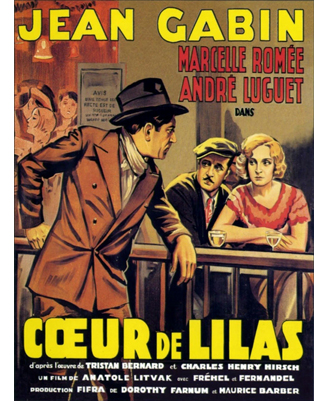 From the heroic thirties, we got the less-seen but still fabled Cœur de Lilas (1931), in which a detective disguises himself as a workman and plunges into the underworld to investigate a murder. The chief suspect, Lilas, is protected by the surly Gabin. From the heroic thirties, we got the less-seen but still fabled Cœur de Lilas (1931), in which a detective disguises himself as a workman and plunges into the underworld to investigate a murder. The chief suspect, Lilas, is protected by the surly Gabin.
In her book on popular song in French cinema, our colleague Kelley Conway has written a superb analysis of Cœur de Lilas, and you can find a clip of Gabin’s big musical number here. Director Anatole Litvak handles his performance in a long tracking shot that keeps our attention fastened on Gabin’s half-scornful, half-boastful mug as he spits out lines about his girlfriend’s bedroom calisthenics (“The rubber kid. . . She dislocates you”).
Gabin plays the third point of a love triangle in Cœur de Lilas, but he’s somewhat more central to the lesser-known Du Haut en Bas (1933), a sort of network narrative that reminds us that The Crime of M. Lange (1936) isn’t the only film tracing the tangled passions in a courtyard community. More easygoing here but still a force to be reckoned with, Gabin plays a footballer with his eye on an aspiring teacher forced to work as a maid. Other plotlines, including Michel Simon’s raffish wooing of his landlady, intermingle in this thoroughly agreeable movie by the great G. W. Pabst.
A generous sampling of Gabin’s later career included La Marie du Port (1949), Le Plaisir (1951), Maigret tend un piège (1957), and the brutal Simenon adaptation Le Chat (1970), the first film I saw on my first visit to Paris. En Cas de Malheur (1957), an efficient plunge into sex and crime by Autant-Lara, features Gabin as a prestigious but dodgy lawyer drawn to the pouting self-regard of Brigitte Bardot. In youth and age, as a sort of French Spencer Tracy, Gabin could exude both relaxed joie de vivre and stolid menace. An icon, as we say.
Americana, urban and rural

State Fair (1933).
Speaking of Spencer Tracy, it was a pleasure to see this Milwaukee native in a long-neglected racketeer drama. Quick Millions (released May 1931) arrived in the middle of the first big gangster cycle and was overshadowed by two Warners hits, Little Caesar (January 1931) and The Public Enemy (May 1931). As part of Dave Kehr’s welcome second Fox cycle, Quick Millions had its own pungent force.
It traces the familiar trajectory of a working stiff, trucker “Bugs” Raymond, who claws his way to the top of the mob. Thanks to blackmail and crooked labor maneuvers (“The brain is a muscle,” he tells his moll), he winds up triggering a spate of gangland killings that eventually swallows him up.
Quick Millions was noticed as one of the earliest films to find a smart tempo for talkies, one that relies less on long speeches than snappy scenes delivering one point apiece. The passage of time is signaled by changing license plates, and the ending is a shrug, shoving Bugs’ death offscreen and giving him none of the tragic flourishes of Little Rico or Tom Powers. For almost every scene, the little-known director Roland Brown finds an unexpected twist in visuals or performance . Who else would film a sidling George Raft jazz dance from a high angle and then supply inserts of his legs, from behind no less?
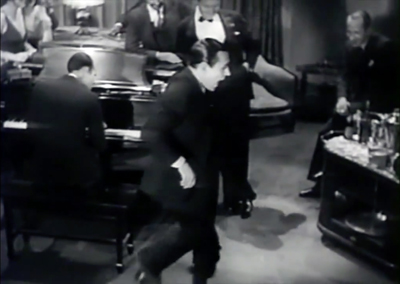 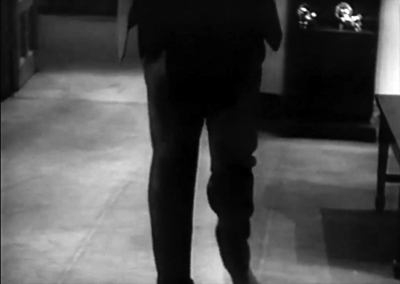
Fox found more success with a folksy Grand Hotel variant based on the popular novel State Fair (1932). Henry King’s 1933 film was planned as an “all-star” vehicle, and it did boast Will Rogers, Janet Gaynor, and Lew Ayres. An Iowa family heads to the fair, aiming for blue ribbons in pickle preserving and hog-fattening. The son has a surprisingly carnal affair with a trapeze artist, while the daughter meets a roguish reporter who makes her rethink her engagement to a hick back home. State Fair‘s script gives the plot a happier ending than the book did, but that’s not necessarily a problem; we want these kind souls to enjoy a bit of glory.
Henry King became famous for rustic realism with Tol’able David (1921), a model for Soviet filmmakers, and Ehsan Khoshbakht’s King retrospective reminded us that he worked this vein a long time. From 1915 Twin Kiddies (a Marie Osborne vehicle) to Wait ‘Till the Sun Shines, Nellie (1952), this loyal Fox craftsman showed himself, like Clarence Brown at MGM, an adaptable director with an unpretentious gift for celebrating small-town life.
Still more, more…
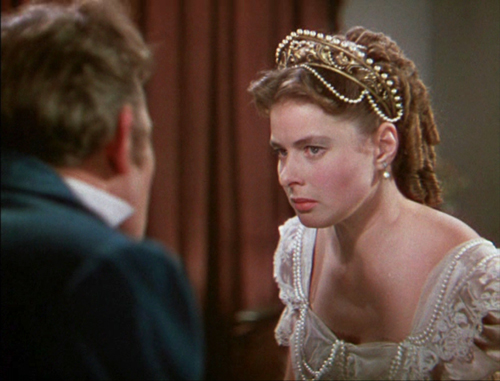
Under Capricorn (1949).
I could go on about other films, such as Zigomar: Peau d’Anguille (“Zigomar, the Eelskin,” 1912), Victorin Jasset’s forerunner of Feuillade’s delirious master-criminal sagas. (In one episode, an elephant’s trunk fastidiously picks the lock on a circus wagon and drags away a strongbox.) Our next entry will spend a little time looking at a neat Genina film from 1919. In the meantime, I’ll sign off by mentioning two other high points.
The pretty Academy IB-Tech print of Under Capricorn (1949) made me like the film quite a bit better than previous viewings. As ever, one high point was La Bergman’s virtuoso soliloquy admitting her guilt. Any other director of the time would have reenacted the crime in a flashback, but, in the shadow of Rope (1948), Hitchcock makes her squeeze out her confession in a ravishing single-take monologue running almost eight minutes.
Its power comes partly from the fact that the framing withholds the facial response of the man who loves her. He’s slowly understanding the depth of her devotion to her husband during penal servitude. “How did you live all those years?” he murmurs. How’d you think? Her glance flicks over him, in both guilt and defiance (above).
Finally, no film gave me more pure pleasure than the restoration of Boetticher’s Ride Lonesome (1959). Sony archivist Grover Crisp explained that the original prints had all been made from the camera negative (!) and so he had no internegatives or fine-grain masters to work from. Nevertheless, this digital version, made in 4K with wetgate scanning, looked superb.
I tend to judge Boetticher westerns by the strength of the villains, meaning that Seven Men from Now (Lee Marvin) and The Tall T (Richard Boone) sit at the top of my heap, but it’s hard to resist the laconic dialogue Burt Kennedy supplied everybody in Ride Lonesome. And the antagonists facing Randolph Scott here–Lee Van Cleef (brief but unforgettable), Pernell Roberts (the good-bad rascal), and sweet-natured dimwit James Coburn (on his way to rangy knife-wielding in The Magnificent Seven)–add up pretty powerfully. Against them stands Scott as vengeance-driven Brigade, an unyielding chunk of sweating mahogany.
Thanks as usual to the Cinema Ritrovato Directors: Cecilia Cenciarelli, Gian Luca Farinelli, Ehsan Khoshbakht, Mariann Lewinsky, and their colleagues. Special thanks to Guy Borlée, the Festival Coordinator. Thanks also to Dave Kehr, Grover Crisp, Mike Pogorzelski, and Geoffrey O’Brien for talk about many of the classics on display.
The entire Ritrovato ’19 catalogue, with full credits and essays, is online here. There are also videos of many events, including master classes with Francis Ford Coppola and Jane Campion.
Quick Millions was remembered several years after its release for “the rapid rhythm of its continuity.” See Janet Graves, “Joining Sight and Sound,” The New York Times (29 November 1936), X4.
John Bailey’s introduction to Under Capricorn included a revealing short explaining the Technicolor dye-transfer process. For further information there’s the remarkable George Eastman House Technicolor research site and of course James Layton and David Pierce’s superb book The Dawn of Technicolor.
Kristin discusses Kiarostami’s landscape techniques in a Criterion Channel Observations entry. In American Dharma, discussed by David here, Errol Morris reveals that Twelve O’Clock High was an inspiration for Steve Bannon’s political career.
The Ritrovato program notes credit Fréhal as the working-class singer in Faubourg Monmartre, but Kelley Conway’s Chanteuse in the City: The Realist Singer in French Film (linked above) identifies her as Odette Barencey, a lesser-known chanteuse of the period who resembled Fréhal.
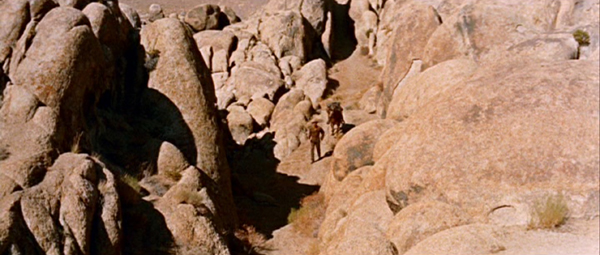
Opening shot of Ride Lonesome (1959).
Posted in Directors: Hitchcock, Directors: Oliveira, Documentary film, Festivals: Cinema Ritrovato, Film genres, Hollywood: Artistic traditions |  open printable version
| Comments Off on Il Cinema Ritrovato: More and more open printable version
| Comments Off on Il Cinema Ritrovato: More and more
Tuesday | July 9, 2019
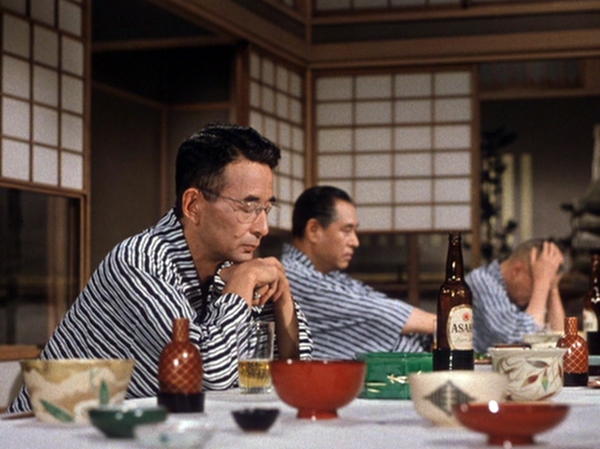
Equinox Flower (1958).
DB here (but writing for Kristin too):
Edward Branigan died on Saturday, 29 June, in Bellingham, Washington. He had fought for a year against Acute Myeloid Leukemia. He was 74.
Edward was an ambitious, highly original film theorist. His first book, Point of View in the Cinema (1984) has become the definitive study of the creative POV options available within “classical” filmmaking. Narrative Comprehension and Film (1994) is a sweeping account of the viewer’s activity in ascribing meaning to stories on the screen. Projecting a Camera: Language-Games in Film Theory (2006) is a meta-level account of how critics and theorists talk about films; it teases out different capacities and qualities we assign to “the camera.” Edward’s last book, published in December 2017 is Tracking Color in Cinema and Art: Philosophy and Aesthetics. It ranges across physics, psychology, art history, and philosophy (mostly Wittgenstein) to explore how we understand and appreciate color imagery.
Edward was also a prodigious editor, producing with Warren Buckland The Routledge Encyclopedia of Film Theory (2015) and with Chuck Wolfe the American Film Institute Readers, a series of forty anthologies on a huge range of topics. He taught at UCLA and Iowa, but his tenure home was UC–Santa Barbara, where he started in 1984 and remained until retiring in 2012.
Keeping in touch
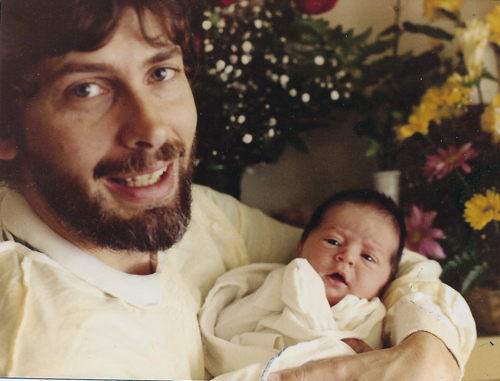
Edward and Evan Branigan, 1984.
So much for a bare-bones Wikipedia entry; Edward deserves a full-blown one as soon as possible. What even that couldn’t capture is the intense admiration, even devotion, he aroused in students and colleagues. He won many teaching awards, including a Distinguished Service Award from the graduate students of his department. For his peers in the profession he was a reliably easygoing, cheerful presence in the sometimes chilly corridors of academe.
Kristin and I met Edward in 1974, and we kept up with his life (one far more dramatic than ours) as best we could, separated by half a continent. Over the decades we visited him occasionally in Santa Barbara and Los Angeles. For too-few times he returned to Wisconsin for summer vacations. Our last reunion was in September of 2016 at a Seattle coffee house.
My email records before 2004 have gone astray, but after that I count over 400 messages, some very long. I could fill this entry with remarkable passages, and I expect other correspondents have equally plump archives. From 2007:
John [Kurten] and I have had three consecutive movie binge weekends. it’s a treat to start watching films in the afternoon and never think about stopping (more or less for two days at a time) — isn’t this what the profession promised?
He often wrote to correct mistakes I made in books and essays, so getting this reaction to my In the City of Sylvia entry left me elated. (Fortunately for me, he hadn’t seen the film yet.) One sequence perfectly fulfilled the conditions he laid out in his POV book.
You madman, it’s brilliant. Your latest blog. Maybe the film, too. From what you say, I thought of layers and uncertainties, intersections and random slidings. Open expectation or expectation opened. Is *Sylvia* for the point-of-view shot, i.e. for a point in space, what *The Conversation* was for sound, *Blow-up* for the photograph, *Time Regained* for memory, and etc.?
When I discovered a “Hitchcock supercut” compiling favorite motifs and themes, I was reminded that in the pre-digital era Edward had mounted something similar for his course.
Thanks for this link. . . . I did teach Hitchcock a number of times in the mid-to-late 80’s. My final lecture was exactly and precisely as described on the link you sent. All (almost) of Hitchcock’s films were represented on two Kodak Carousel projectors jammed full. I projected two simultaneous images side by side of visual motifs (staircases, camera movements…etc.). Slow dissolves between each pair of images to the next pair. I made a music tape and keyed certain images to climaxes in the music. Only taught the course in the 80’s. Seems an age ago. Not to mention the changes in technology. I have ten metal cases of slides that are orphans now with no projectors. As do you and Chuck [Wolfe] with many more cases. I had some of my slides digitized, but the quality was disappointing.
But later he reports his house fire:
I have realized that my eight cases of 35mm slides taken directly from 16mm prints — collected since 1974 — are gone in the fire, including a slide from every setup of An Autumn Afternoon.
Speaking of Hitchcock, in 2012 I told him that Sir Alfred would have a place in the book I was planning on the 1940s. This got him going:
Mr. missed D.,
Rethinking Hitchcock! I want to read it. . . . Nice to hear from you generally and I trust you and KT to be well. I suspect the latter has seen The Hobbit many a time so far and planning still more viewings. Nicholas and I are in Seattle. This morning after a large breakfast (omelet, steel-cut oatmeal, hash browns, muffins, black tea) I watched out a tenth floor window as the monorail docked at the Space Needle, while visiting my parents and the other Usual Suspects (i.e., relatives), and planning further hiking, movies, bridge, serious eating, shopping ski apparel activities, and so forth. It’s fairly deeply relaxing here. (It suggests what retirement could be for me in Summer 2014, retirement being in name only at the moment.) I saw two float planes land on Lake Union, taxiing to the shore, water spraying up over the floats, red and green lights continually snapping on and off on both wings (i.e., not one red on the left wing, one green on the right wing). Interstate 5 is in the distance, the car headlights of morning commuter traffic turning it into a winding white snake as the day is strongly grayish, clouds about 40 stories up, swirling, banking up, no sign of sky (thus solar panels are useless), the Olympic Mountains are in the distance, people are walking on the streets below this way and that with purpose, with destinations firmly in mind. Have I mentioned the large rotating, neon pink elephant sign glimpsed in the distance between some buildings that advertises simply, “Car Wash,” as if it doesn’t rain often in Seattle? The sign stops briefly on every rotation to shine out its message in white neon bulbs, “Car Wash,” the message never changing. Up here I’m living in a parenthesis. Looking out at a vast aquarium.
He never forgot my birthday. This is from 2014, as is the photo at the bottom.
HB, big guy. Wherever you are, it’s still HB. Thinking of you.
I’m traveling for a month, meeting many persons, hiking above the treeline in the Rockies, World Lacrosse Championships, Denver, Boulder, Fort Collins, Estes Park, The Stanley Hotel (think The Shining), Seattle, northern Wisconsin, seeing all the sons, and more. Consulting on two legal cases. Have no time. Retirement is the bestest. Even trying to write.
From 2018:
I’ve seen Blade Runner 2049 seven times. A masterwork. Been drinking the Blade Runner Director’s Cut Johnnie Walker Black Label Scotch in the film’s Italian crystal glasses. Watched all sixteen episodes of the Netflix series, Babylon Berlin, in three nights. Should interest you in terms of detective fiction. First-rate fun. Weimar seems like hell with all its circles intact. It’s not up to Fassbinder’s Berlin Alexanderplatz, but what is?
During his cancer treatments, he managed to keep corresponding. Although the paragraphs got shorter, the tone never changed. This from May of this year:
I appreciate your generous words and kind thoughts. I haven’t been feeling well. The blasts have been creeping back. . . . More chemo is likely, maybe a clinical trial. . . .
Enemy. The film streams on Netflix. Take a look. Don’t read anything about it, and its shocks, until it settles on you.
Game of Thrones ends tomorrow for all time until the HBO prequel is ready. I think Dany is killed by Ayra disguised as Tyrion. Jon Snow moves the Iron Throne to Westeros with him upon it.
He inevitably signed these energy bursts, “Kindest, E.”
The 70s: Beyond the New Hollywood
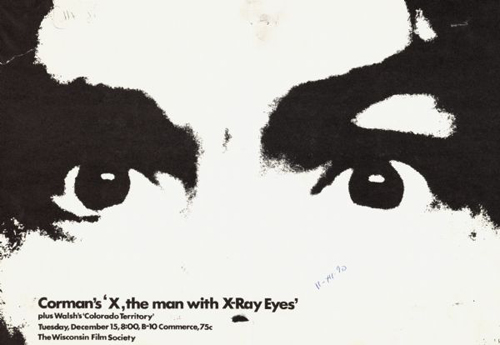
Wisconsin Film Society poster, 1970.
My most vivid memories come from the years we knew him as a student and friend here in Madison. He was part of a thriving intellectual community that, from the distance of today, informed our lives in deep and lasting ways.
Edward, Vietnam veteran (Marines, Communications), took a film course with me in spring 1974, his final year of law school at UW. It was my second semester of full-time teaching. He then signed up for our graduate program. I shouldn’t have been surprised by his shift of career. As an undergraduate he had majored in Electrical Engineering and English. He also wrote poetry.
He entered a community bursting with talent. When I got here in 1973 I was handed four superb TA’s: rigorous and righteous Doug Gomery, witty and charming Brian Rose, meticulous silent-film aficionado Frank Scheide (who looked like a young Buffalo Bill), and already stunning experimental filmmaker James Benning. There was Maureen Turim, fresh from a year in Paris and immersed in Bresson and the avant-garde; Diane Waldman, who’d write the still-definitive account of Hollywood’s female Gothics; Fina Bathrick, who was researching family melodrama before almost anybody else; Marilyn Campbell, the first I think to analyze the Fallen Woman film of the 1930s; Bette Gordon, already at work on her own fine films; and Peter Lehman, already an eloquent advocate for John Ford, Blake Edwards, and Roy Orbison. While everybody else was hot for the new Hollywood, we were into the old one, along with films from beyond the US that later would gain their proper recognition.
Coming in the door were still more gifted grads: Vance Kepley, Janet Staiger, Kerman Eckes, Barb Follick, Barbara Pace, Nancy Ciezki, Diane Kostecke, Mary Beth Haralovich, Cathy Klaprat, Don Kirihara, Darryl Fox, and on and on. I was also establishing ties with young scholars elsewhere: Phil Rosen, Mary Ann Doane, and Bobby Allen at Iowa; Noël Carroll, Paul Arthur, and Tom Gunning at NYU. Networks and enduring friendships were forming. An actual academic field was emerging.
Like every young faculty member, I was learning on the job. I was groping to figure out the problems that interested me most–film form and style, considered in a comparative historical context. The BFI magazine Screen was having a big impact, but so were translations of works by Noël Burch, the Russian Formalists, and French Structuralists. Feminism, neo-Marxism, and Third World politics found their way into our curriculum. Barthes’ S/z became a constant reference point. I went on WORT radio to defend semiotics and The Godfather.
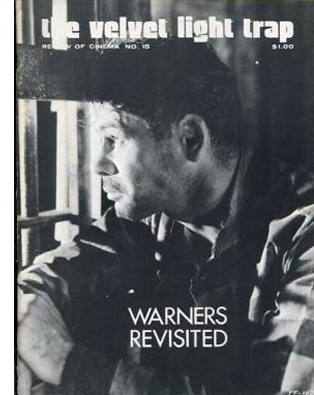 Just as important, American distributors like New Yorker and Audio-Brandon were releasing new European and Latin American titles as well as old works from Asia. In those pre-video days, 16mm prints were our best chance to catch up, not just through classroom showings but through the twenty-plus campus film societies. (There were Sam Fuller double features, but also Godard retrospectives and political documentaries.) And we had The Velvet Light Trap, which published zesty in-depth studies of genres, studios, and auteurs. The campus was movie-mad. Just as important, American distributors like New Yorker and Audio-Brandon were releasing new European and Latin American titles as well as old works from Asia. In those pre-video days, 16mm prints were our best chance to catch up, not just through classroom showings but through the twenty-plus campus film societies. (There were Sam Fuller double features, but also Godard retrospectives and political documentaries.) And we had The Velvet Light Trap, which published zesty in-depth studies of genres, studios, and auteurs. The campus was movie-mad.
In my seminar on “Classical Hollywood Cinema and Modernist Alternatives,” we analyzed random titles from the Warners and RKO archives alongside Ordet, Equinox Flower, Four Nights of a Dreamer, and Chronicle of Anna Magdalena Bach. The Student Union screened Play Time in 35 across a whole weekend so my theory class could write essays on it. We brought touring Japanese, French, and Italian film packages to campus.
His Girl Friday, Meet Me in St. Louis, Possessed, Naniwa Elegy, Genroku Chushingura, Tom Tom the Piper’s Son, Death by Hanging, The Man Who Left His Will on Film, The Red and the White, and many other films became touchstones for us. In the midst of all this, senior colleague Tino Balio helped us see how to tie aesthetic analysis to the protocols of national film industries and similar institutions. He became a good friend and ally in many skirmishes, as did Jeannie Thomas Allen, with her work on women and media.
For Kristin and me, the years 1973-1980 crystallized research programs we never left behind. In these years I wrote my Dreyer book, Kristin did her dissertation on Ivan the Terrible, and we published Film Art: An Introduction. With Janet Staiger we began work on what became The Classical Hollywood Cinema. Meanwhile, our students were writing articles for journals and showing up en masse at conferences, a good-natured mafia.
Edward plunged into this and never looked back. He made an offbeat, poetic narrative film (which I hope his family can locate). He ran scenes to and fro on our Steenbecks and analytical projectors, checking match cuts and camera movements. He and Kristin drove down to Chicago for back-to-back screenings of Lancelot du Lac. He began writing on film color, a focus of his research for the next forty years. Above all, we were bound together by Ozu.
Tokyo Story was circulating in 16mm after its smashing New York revival in 1972, and Audio-Brandon and New Yorker acquired several more Ozu titles, early and late. That began our love, or rather mania, for this director. We three watched those prints over and over, eventually writing two essays for Screen in summer of 1976. Edward hoped for a long time to write his doctoral dissertation on An Autumn Afternoon, planning to devote an entire chapter to the woman in the red sweater who passes through scene after scene.
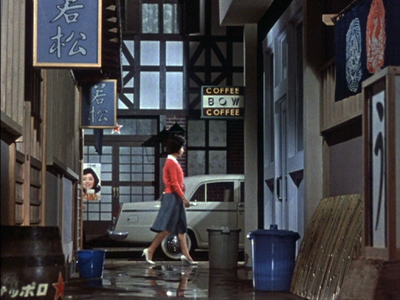 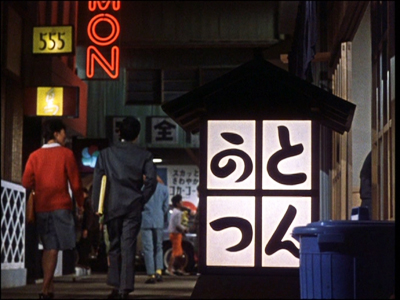
I still want to read that.
Ozu was never far from our thoughts. When Edward finished his dissertation, he gave me a framed still from Equinox Flower. It surmounts this entry. I learned so much from our conversations that I dedicated my Ozu book to him, with a Japanese inscription that means “the pupil who teaches the teacher.” As soon as the book went online, he wrote to tell me of Net problems.
I downloaded the Ozu book. Now, how do I get the color photos and the new crisp b&w’s? Must they be downloaded individually, one at a time? I want them in the book. I want them.
Thanks to his persistent pressure, the University of Michigan created a smoother download.
One constant point of discussion in the 70s was Ozu’s red teakettle in Equinox Flower. When in 2011 Kaurismaki noted it, I sent the link to Edward. He replied:
The red teakettle was a killer for sure. I never really leave the 70s and Vilas Hall… Late nights. 16mm stop motion. I also very much appreciated your blog entry on the four looks at Ozu. Shouldn’t you at some point do a streaming video for your blog?
Sometimes Ozu was merely evoked, not mentioned. One email had this attachment.
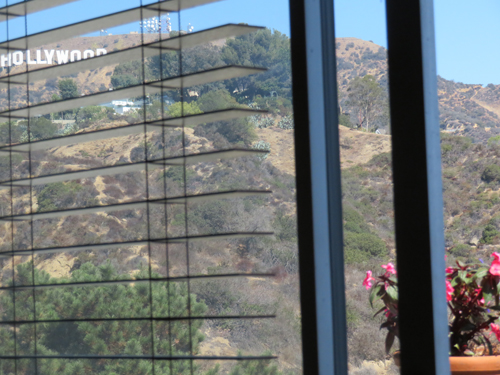
Edward knew I would immediately think of a shot from Dragnet Girl and two from Early Summer.
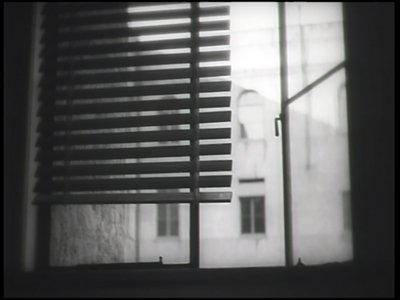 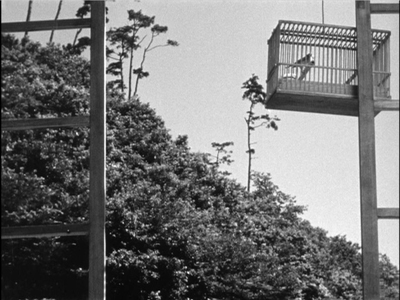 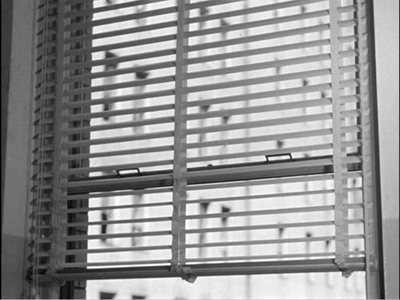
My last email from Edward in May includes this:
Ozu… A year ago I looked at all six of his color films. The color designs are distinctive and sophisticated, but perhaps too complicated to write about. . . .
If he were still with us, I bet he’d try.
Edward’s vitae is available here.
We’re grateful to all those who have shared Edward’s company with us over the years. Vance Kepley helpfully corrected my memory of the 1970s. Thanks especially to Roberta Kimmel and Evan Branigan, who sent us bulletins.
P.S. 9 July 2019: Thanks to Chuck Wolfe, Edward’s tireless colleague at UCSB, for correcting my initial claim about his undergraduate major.
P.S. 12 July 2019: The Film and Media Studies Department at UCSB has posted its tribute to Edward.

Edward Branigan, 1945-2019.
Posted in Film theory, People we like, Readers' Favorite Entries, UW Film Studies |  open printable version
| Comments Off on Kindest, E.: A memoir of Edward Branigan open printable version
| Comments Off on Kindest, E.: A memoir of Edward Branigan
|









































































